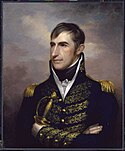Battle of Tippecanoe
The Battle of Tippecanoe was a decisive victory by United States forces led by then-Governor of the Indiana Territory William Henry Harrison over the forces of Tecumseh's growing American Indian confederation. The battle took place outside Prophetstown, near present-day Battle Ground, Indiana, and was part of what is sometimes known as Tecumseh's War, which continued into the War of 1812.

On November 6, 1811 approximately 1,000 riflemen under the command of Harrison approached Prophetstown. Their march intentionally coincided with Tecumseh’s absence; he was traveling through the southern states in an attempt to recruit more tribes to his alliance. Tecumseh left Prophetstown under the leadership of his younger brother, Tenskwatawa, also known as the Prophet. Field command was given to a Shawnee chief named White Loon. Fewer than a thousand warriors plus women and children occupied the village.
When Harrison's forces came into view late on November 6, a young Indian on horseback rode out from the town waving a white flag. He carried a message from the Prophet requesting a cease fire until the next day when the two sides could hold a peaceful meeting. Harrison agreed but was wary of the Prophet's overture and kept a number of sentinels on duty over night.
Although existing accounts are unclear about exactly how the skirmish began, Harrison’s sentinels encountered advancing Indians warriors in the pre-dawn hours of November 7. As the soldiers awoke to scattered gunshots they discovered themselves almost encircled by the Prophet’s forces. Fierce fighting broke out as the Indians broke through Harrison’s lines and entered the camp. As the sentinels fled back to camp the volunteers quickly regrouped and repulsed the advance while securing their own lines. Throughout the morning Harrison's troops fought off several charges before the Indian forces finally retreated. Harrison had 68 men killed or mortally wounded, and about 120 less seriously wounded. The number of Indian casualties have been variously given, but historians estimate that 50 or more were killed, and about 70-80 were wounded.Template:Fn
Fearing Tecumseh's imminent return with reinforcements, Harrison ordered his men to fortify their position. The next day, November 8, he sent a small group of men to inspect the town. Accounts differ as to what happened next. The soldiers claimed to find the town deserted except for a single elderly woman. Other accounts claim a number of women and children were slaughtered. Eventually Harrison's troops burned Prophetstown and left.
The Battle of Tippecanoe was a crushing blow to Tecumseh's dream of a unified Indian confederacy. The Prophet, having prophesied that the weapons of Harrison's men would not be able to hurt his warriors, was disgraced by his failure and fled to Canada. Although this battle was crushing, it was not until 1813 at the Battle of the Thames and the death of Tecumseh that his confederation was eliminated.
Notes
- Template:Fnb Casualty figures and force sizes from Prophet (Lincoln: University of Nebraska Press, 1983) p. 115.
